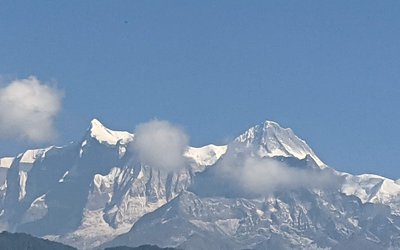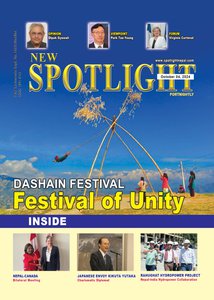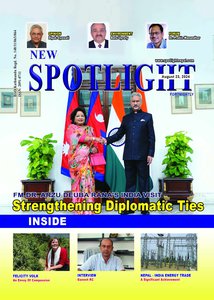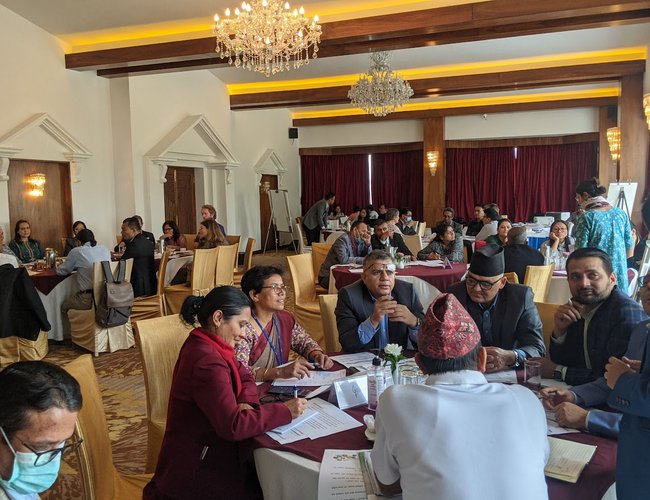
The initiative generates longer term visions and actions for managing water in nations like Nepal by bridging the gaps between knowledge, policy, and action. Officials from Nepal's government, policy makers, scientists, NGOs, youth, academia, corporate sector, and development partners recently convened a high-level multi-stakeholder conversation on TFWS and shared their experiences to advance the TFWS missions emerged through south-south learning and multi-stakeholder consultation processes. .
Everywhere in the world, the water system is being impacted by an increase in extreme weather events and changing rainfall patterns. But Nepal, one of the most vulnerable nations, has already begun to experience increasing temperatures, cloud bursts, droughts, floods, glacier lake outbursts, and dwindling water streams.
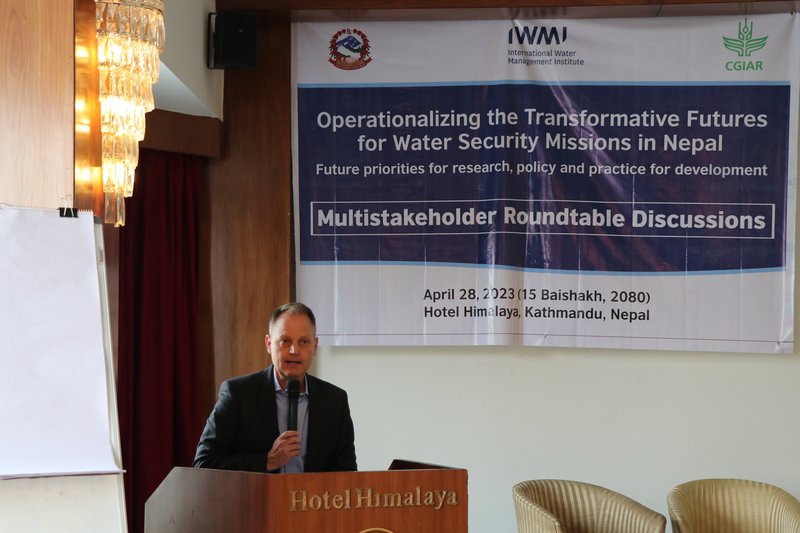
A glacial lake outburst in Darchula, in the far western region, just at the end of April 30, 2023, devastated roads and bridges and killed four people. In Jomsom, south of the Himalaya, more than 60 MM of rain fell in a span of 10 hours in October of last year, washing away roads and other infrastructure in the Kaligandaki river.
Approximately 100 kilometers north-east of Kathmandu, on the Melamchi River, a flood, in 2021, swept away roads and residential areas, burying the headwork of Nepal's largest drinking water project. The end of October in 2021 had significant rains, which severely ruined a lot of cropland.
These were the very few instances of extraordinary events. However, Nepal has been experiencing extremely heavy rain and hot weather on a nearly daily basis for the past few decades. Another unprecedented year without any winter precipitation was 2022.
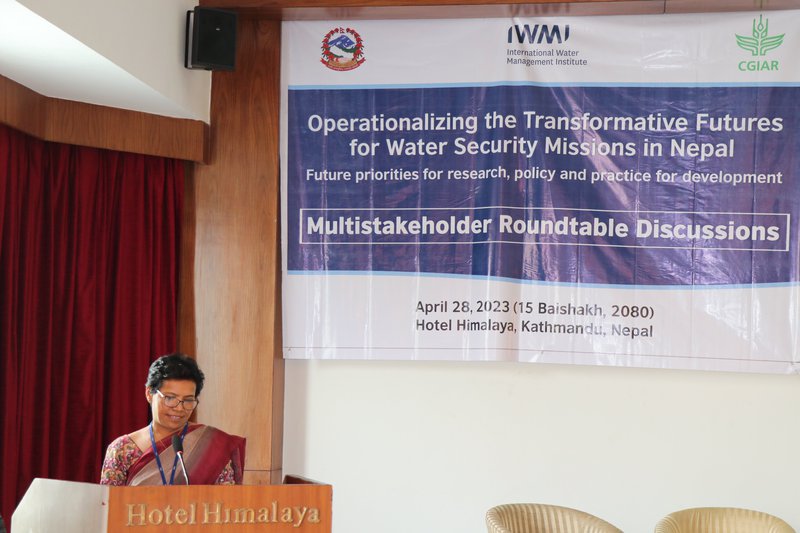
Recent years have seen an increase in the frequency of extreme weather occurrences in Nepal, including floods, droughts, forest fires, rising temperatures, and landslides. Both the flow of water and agricultural production have been impacted by this change. Natural catastrophes or water-related calamities cost Nepal between 3 and 4% of its GDP.
Water security is crucial in Nepal's context because of the difficult environment there. However, nations like Nepal need a scientific foundation and the cooperation of various stakeholders and institutions involved in water science for development.
Policymakers and stakeholders are looking for sustainable methods for water security as the situation in Nepal is getting worse. Working closely with the Nepali government, various water-related organizations, and development partners while there, IWMI in collaboration state and non-state actors, including youth has initiated the TFWS initiative that generated high-ambition missions for supporting policymakers, investors, practitioners and local communities to address water challenges through collective actions. Globally, rising temperatures are affecting the hydrological cycle and moisture content. More droughts and floods are causing life to be disrupted. As the pattern of rainfall shifts and becomes more uneven, the availability of drinking water is reduced, and water for irrigation disrupts all life cycles. The IPCC stated in 2021 that the process of extreme weather will make it more difficult to attain water security.
TFWS, a multi-stakeholder, participatory, and science-based approach witheight missions and related transformation strategies for water security, as an international organization supporting nations like Nepal with new strategies and expertise, can assist nations like Nepal in achieving water security for sustainable development.
At a multi-stakeholder roundtable discussion recently organized by IWMI on "Operationalzing the TFWS in Nepal," representatives from the government, academia, development partners, NGOs, and young people discussed strategies and prioritized tasks for advancing the TFWS missions for water research, policy, and innovation in Nepal.
The roundtable discussionhad three objectives: Create a shared understanding of the high-ambition TFWS missions for science-based actions for water security; - Talk about ways to advance TFWS missions while aligning Nepal's development priorities, policies, and programs; - Identify water knowledge, research, and innovation priorities on which IWMI and partners should concentrate.
During the roundtable discussion, Dr. Mark Smith, Director General of IWMI, described the procedures and results of TFWS. Dr. Smith emphasized how this strategy might assist Nepal in achieving future water security by working with collective, consistency, shared purpose, and concentrated investments.
On the basis of the TFWS missions, he said that discussions with the government, business community, donor organizations, academic community, research institutions, and youth organizations helped to focus on goals and practical steps for water research, policy, and practice in Nepal.
Discussions lasted three hours, during which time participants covered a number of important topics, including groundwater management, studies on upstream and downstream linkages, sustainable water governance, and multi-stakeholder platforms on water security. Participants agreed that the mission's top aim should be to increase farmers' resistance to water and climate change hazards and conservation, management and sustainable use of freshwater resources.
Life is dependent on water resources, as One of Nepal's top ten most pressing public health concerns is the prevalence of diseases connected to water and sanitation. It is still difficult to provide safe water for drinking, sanitation, and other uses, particularly for women, the poor, and other marginalized groups in society. The water sector continues to be crucial as Nepal moves closer to attaining the SDGs by 2030.
Although 95% of people have access to a basic water supply, only 19% of the total population in the country have access to safely managed water. 95% of people have access to basic sanitation services, but only 61% have access to properly managed sanitation services.
What is TFWS Process?
To boost the response to urgent water security concerns resulted in due to climate change and other drivers, the IWMI lead TFWS idea to bring multiple stakeholders to discuss and identify collectively high-ambition missions for science-based actions on water security. In order to focus and deepen the scientific basis for action on water security, the TFWS seeks to forge alliances and collaborations among the policy, business, development practitioner, and scientific communities. It does this by fostering south-south learning, while balancing the views of the Global South and Global North.
The multi-stakeholder driven consultation , which is led by mission-driven coalitions, intends to ensure that scientific advancements are better used to support political progress toward a more urgent and unified agenda for water policies, investments, strategies, and rapid action.
The TFWS effort will highlight the importance of water research and innovation in order to hasten the transition to a future with secure access to water. The program will work to improve the relevance, accuracy, and accessibility of water-related science and evidence by reducing their fragmentation. With greater water data and expertise, it will assist policymakers and stakeholders from all sectors in overcoming gender disparities, social exclusion, and weak governance and institutions that impede progress on water security.
Eight missions have been discovered via TFWS processes. There are also strategies. These are all common goals at all levels, from local to international.
Building farmers' resilience to climate change and water risks is one of eight missions, along with providing sustainable, stakeholder-driven WASH services, increasing the availability of freshwater, future-proofing water infrastructure, removing data and information barriers, making water decisions that are fit for the future, providing good water governance and cross-border cooperation, and adapting to changing water regimes and risks.
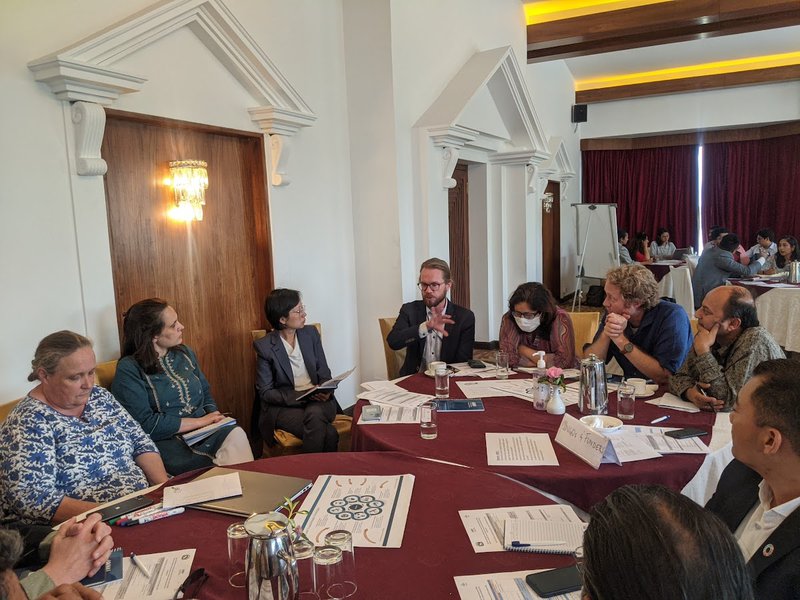
For this, coordinated efforts from implementations at three levels, including investment, policymaking, and innovation are needed.
How to reduce the effects of climate change globally and create innovative adaption plans. This is the result of teamwork, with the government, business sector, and engineers guided by water science and engineering.
Through these mission, the research and engineering fields in the water sector must assist other stakeholders in comprehending the water challenges and in figuring out how to approach the problems in a cooperative or holistic manner because they are not monolithic but rather very complex and competitive in terms of social dynamics, environmental concerns, governance, policies, investments, and technology related to water data and water science.
Disparity in Distributions
Despite Nepal having 225 billion cubic meters (BCM) of water per year, not all regions and sessions have equal access to water. Precipitation is at its highest during the monsoon season, when over 80% of it falls, and at its lowest during the other eight months. Similar to how rainfall patterns vary, Nepal's biological regions' east and west have diverse climates.
According to studies, the next eight months are highly water scarce, which causes water stress and droughts. In the longer term, a likely decline in lean season flow due to the retreat of glaciers and increasing evaporation has the potential to induce regional inequality and worsen such unpredictability.
Over four-fifths of all water used is used by agriculture, making it the biggest user. Only one-third of the irrigated land has year-round irrigation facilities, and only about 50% of the 2.2 million hectares of potentially irrigable land have access to irrigation infrastructure.
In spite of this, 40% of the irrigable land in the southern plain, where production is higher than in hills and mountains, will be irrigated. poorer crop intensities and poorer land and agricultural output have been caused by a lack of dependable access to enough water when needed.
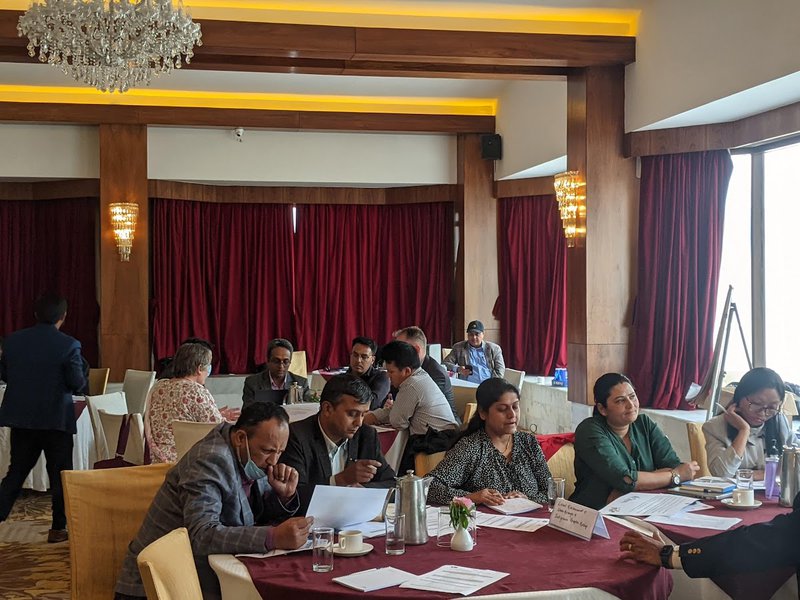
Nepal is regarded as a country with a great potential for hydropower generating because of its ideal geography and abundance of water. However, only a little more than 2,400 MW of the economically feasible potential of 43,000 MW are utilized. However, variations in the pattern of rainfall and the availability of water have also been affecting the hydropower generation capacity.
Out of a total capacity of 2400 MW, Nepal generates about 1000 MW during the dry season as a result of retreating glaciers and shifting rainfall patterns. Power generation during the rainy season and the eight-month dry season differs significantly.
The reality contradicted experts' claims that water resources can help Nepal's economy, reduce poverty, and advance the country's development.
In this scenario, achieving the SDGs for climate, food security, energy, environment, poverty, gender equality, and health is dependent on water security.
Some people advocate taking more action. "Climate change, social injustice, and gender inequality call for greater action. There are many chances to develop and put into practice inclusive and participatory planning in the water sector now that Nepal has a federal structure in place as of 2015. It is very important to spend more in science and to inform decision makers to engage with a science-based approach when managing water resources in a changing social, political, and economical context. IWMI has been pushing a multi-stakeholder approach in the area of water resources management in collaboration with other stakeholders. TFWS is so pertinentto foster collective actions for water science-based actions for sustainable developmentaccording to Dr. Manohara Khadka, IWMI Nepal's national representative. Following these discussions, it appears that all interested parties understand the significance of the TFWSmissions and strategies emerged from the multi-stakeholder dialogues processes. The TFWS missions and strategies were identified through conversation among 1000 participants from more than 400 different organizations at the local, regional, and global level process.
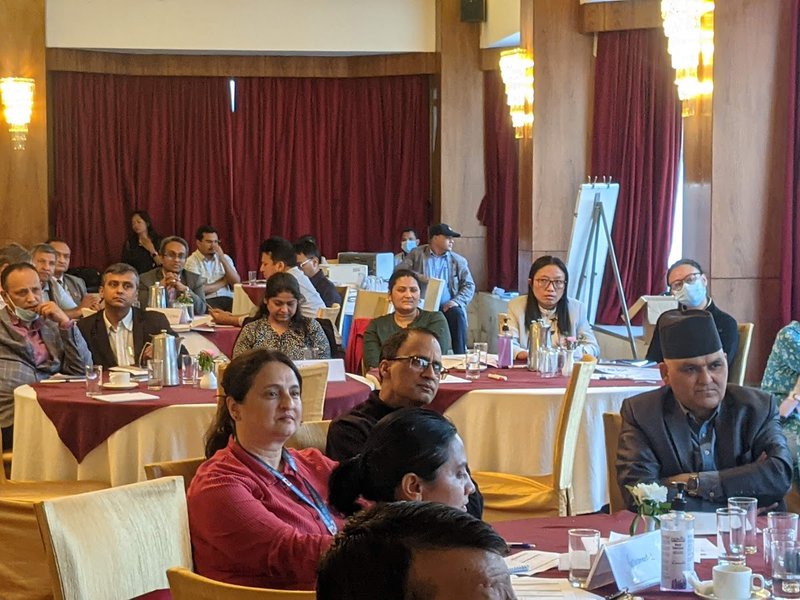
"This is a multi-stakeholder approach that is driven by research to examine the water concerns and how the future will be affected by climate change. Government, policymakers, implementers, youths, academic institutions in the commercial sector, development partners, and civil society are all involved in this process and youths were the co-guardian of this processes. Dr. Khadka stated, "We have broad eight stakeholder groups involved in this TFWS processes
The meeting, according to Dr. Smith, Director General of IWMI, is planned to examine how we can strengthen our partnerships and collaboration as we carry out the TFWS agenda to achieve water security.
In addition, he stated that the discussion's goal was to relate past initiatives IWMI has already carried out in Nepal and other countries, and IWMI’s future Research and Innovation strategy would also require to align with these TFWS missions that are developed with our partners and stakeholders as collective missions of water security.
"We started the TFWS process a year ago after realizing how useful it would be for the UN Water Conference in 2023. We are aware that when the government came together to plan that summit, concerns over the future of water would increase. So, we in IWMI started to think what we can contribute to the water security in global, regional and national level,” said Dr. Smith.
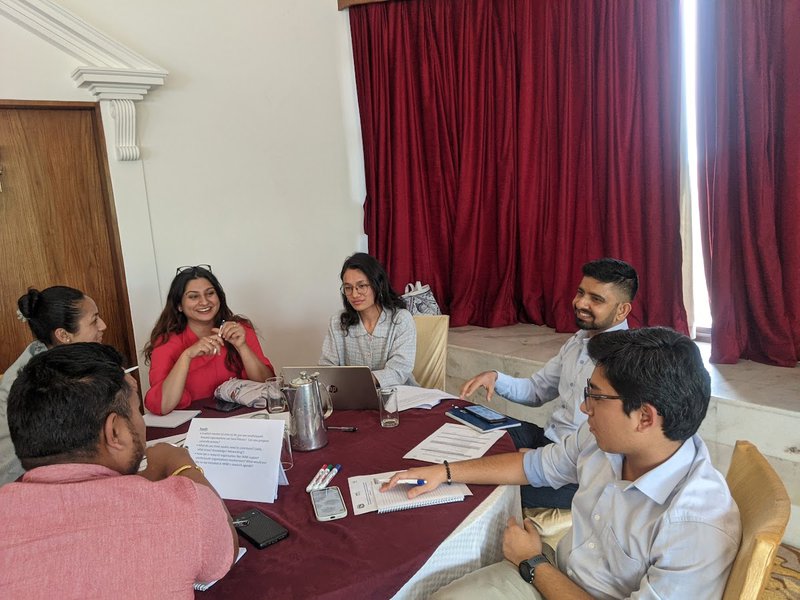
Nepal’s Participants of TFWS
Participants from Nepal who attended the TFWS global conference in Cape Town, South Africa, shared their experiences throughout the talks.
The discussion, which was moderated by Dr. Santosh Nepal, Researcher, Water Resources and Climate Change IWMI-Nepal, focused on priorities and areas where Nepal falls short. He also discussed Nepal's advantages and disadvantages in terms of water security.
"Water is of the utmost importance to Nepal since it dictates the future of the nation. Making an attempt to center water science in the minds of policymakers is necessary as climate change escalates so dramatically, to equip young people with the knowledge, skills, and resources they will need to build a world with secure access to water, said Dr. Nepal.
Five Nepalese participants who participated in the TFWS process at the national, regionaland global levels expressed their perspectives on the process. The Deputy Director General of the Department of Water Resources and Irrigation, Mr Tika Ram Baral highlighted the importance of multi-stakeholder driven approach to identify the TFWS missions and strategies. Sharing his experience, the TFWS dialogue is a very stakeholder-friendly approach, according to Professor Vishnu Prasad Pandey of the Institute of Engineering. Every viewpoint mattered. When we discuss the nation, we can more clearly talk about the actions. Instead of setting the goal, we were determining how to achieve it. Water is a resource that caters to multiple stakeholders. If you connect with the organization where I work, we are figuring out how to connect.
The lesson is that we need to go from a typical approach to solely academic research to one that is action-oriented. While moving forward presents challenges, we are aware of the current course. There are eight missions, however they are all interconnected.
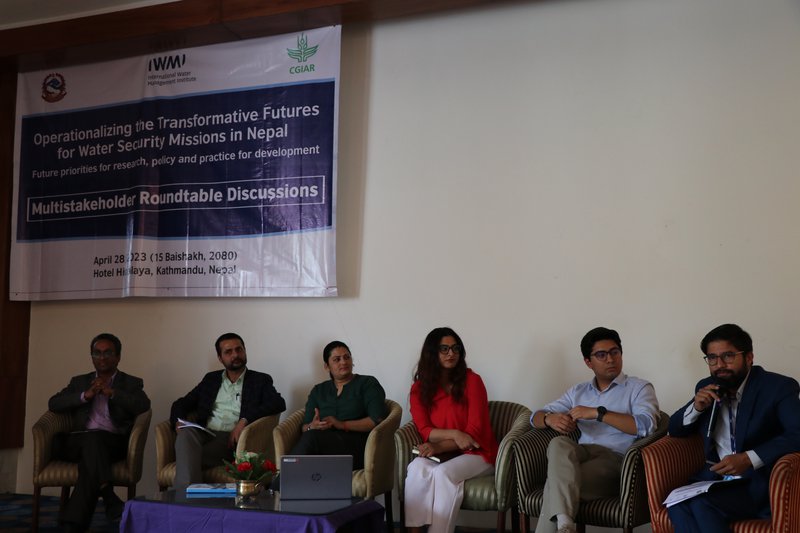
The lesson for my engineering institute is that we provide a variety of courses in the fields of water, energy, disasters, environment, land, and water. Thus, it was relevant to us as well. A high caliber of alumni with sway over decisions are being produced by the engineering institute.
The problems raised during the process, according to another participant Tara Giri, who represents the National Association of Rural Municipalities in Nepal, were extremely pertinent and helpful for the nation to achieve water security. According to Giri, another crucial aspect of the discussion was the participation of a sizable number of young people, scientists, and implementers.
Anju Panta, of the Youth Alliance for the Environment, and they talked about Nepal-specific concerns, possibilities, and gaps. All state holders are included in the process, according to Panta.
Raunak Shrestha, of GWP South Asia, emphasized the process, adding that the involvement of youth stakeholder groups is very important. In shaping the future of water security, he remarked, the role of youth is crucial.
Discussion And Sharing Views
Multiple stakeholders are involved in the complex issue of water. The only way the nation can close the gap between research and policy, business and development, and a more sustainable, resilient future is through strengthened partnerships among various stakeholders.
Bold ideas and quick action are needed to address the difficulties of the present and the uncertainties of the future. Local farmers and community members at the basin level, where the public and private sectors can work together to manage water competition among various users, spur investment, construct infrastructure, and safeguard the environment.
At the regional level, trans-boundary cooperation at the global level where public and private sector and civil society can foster on action on water security through policy innovation, financing water data for planning and decision making, research and knowledge sharing. We cannot make water security on past assumption but there is hope as solution have already been developed and implemented and scaled all over the world.
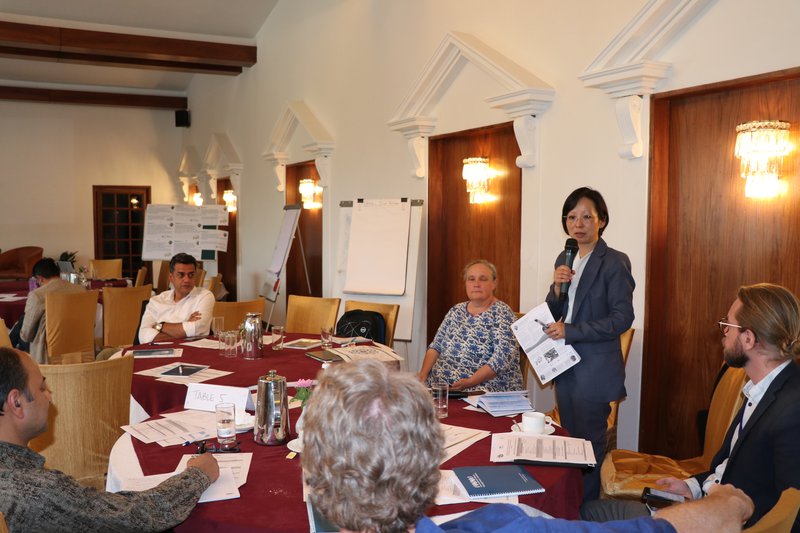
"The Ministry of Energy, Water Resources, and Irrigation seeks to solve the concerns of water security by working closely with IWMI, development partners, other government authorities, the business sector, NGOs, and farmers. The purpose outlined by IWMI about the TFWS missions and strategies is pertinent since water concerns include a variety of stakeholder groups.We have learned a lot from being involved in the TFWS dialogues and missions identification processes,” said Susheel Chandra Acharya Department of Water Resources and Irrigation Director General.
"Water pollution, urbanization, violence, and a lack of infrastructure have all been problems in Nepal, and they are only becoming worse. The traditional method of understanding about rainfall and the water system is no longer valid due to the shifting weather patterns brought on by the climate, according to Acharya, Director General of the Department of Water Resources and Irrigation.. We can benefit from collective actions to the implementation of TFWS missions. In this sense, the government is prepared to continue its collaboration with IWMI.
According to Dr. Govinda Sharma, secretary of the Ministry of Agriculture and Livestock Development, the conversation was crucial for us to understand the water security. Climate change is impacting agriculture sector in various ways. We need drought or flood prone crops. Implementing the programs based on TFWS missions/purposes helps Nepal avoid a water crisis in the context of climate change. In this regard, the Ministry of Agriculture and Livestock is prepared to engage closely with IWMI, according to secretary Sharma.
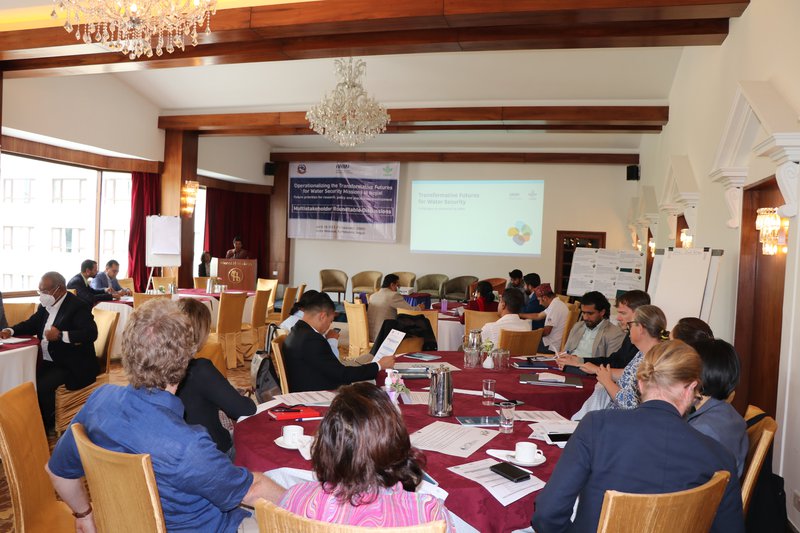
A multi-stakeholder roundtable discussion on operationalizing transformative futures for water security in Nepal: future priorities for water research for development was attended by representatives from Nepal's many stakeholder groups.
Several experts express their opinions during the roundtable discussions, which are moderated by Shivani Chemjong. According to Dr Prachanda Man Pradhan, a prominent community-based water activist, "There is a limited investment in research, academic institutions, and innovation of technology to promote women related irrigation and farmer led small irrigation, drinking, and farmer led institutions." Private sector investment is essentially non-existent in the drinking water, irrigation, and sanitation sectors, in contrast to the hydropower sector."
What were the attendees' main points of debate about Nepal's priorities for development? What impact can the TFWS missions have on these priorities? What countrywide laws and initiatives are already assisting in the missions? What's lacking? What should IWMI and its partners prioritize in terms of knowledge, research, and innovation?
In order to ensure future water security, Tripti Rai, Country Director for Water Aid in Nepal, expressed the view that all stakeholders must work together.
Water resources, according to Rai, are essential to achieving the SDGs because they are a crucial link between the development of the energy, food, and ecosystem systems as well as a key factor in food production, tourism, industries, water supply, sanitation and hygiene (WASH), livelihoods, and the preservation of biodiversity.
The conversation and agenda, according to Sagar Prasai, advisor on water governance at the Australian Embassy, are borderline. He recommended that there should be warnings when discussing implementation. We continue our work in the two main areas of Australian government policy, water and climate change.
In order to further #TFWS missions for water research, policy, and innovation in Nepal, we will talk about next steps and decide on priorities, according to Dr. Smith.
As the world warms, water security will become more of a concern. Discussions with the government, corporate sector, development partners, academia, research institutes, and youth organizations helped concentrate on objectives and practical steps for water research, policy, and practice in Nepal. In this situation, TFWS missions call for collaboration and conversations that attempt to bring together business, policy, and research with bottom-up involvement and groups driving change.
A core group of Global South and the Global North organizations will make up the convening partners, who will then mobilize a larger network of actors, including those operating at the regional and national levels.


Keshab Poudel
Poudel is the editor of New Spotlight Magazine.
- BEEN: Honoring The Contribution
- Oct 22, 2024
- Nepal Commemorates 7 October And Calls For Release Of All Hostages Including Bipin Joshi
- Oct 07, 2024
- JAPANESE ENVOY KIKUTA YUTAKA: Charismatic Diplomat
- Sep 25, 2024
- POLITCS: Do Or Die
- Sep 13, 2024
- OLI’S INDIA POLICY: Nationalist Rhetoric, Anti-Nepal Outcomes
- Sep 11, 2024












